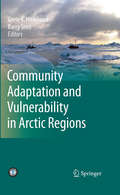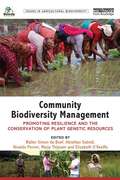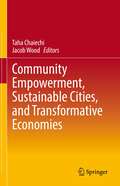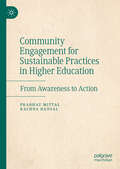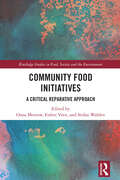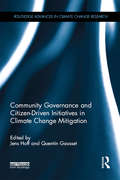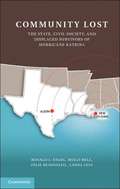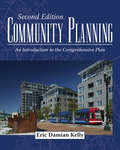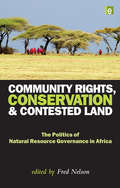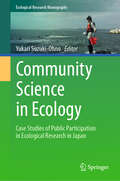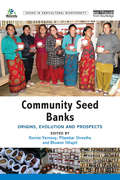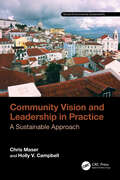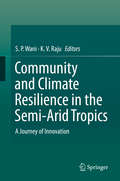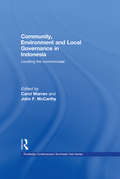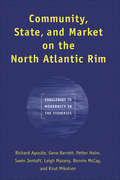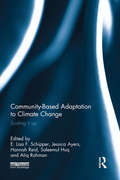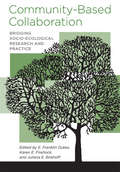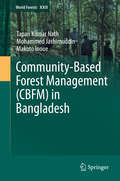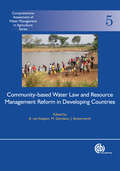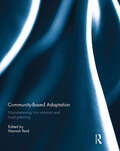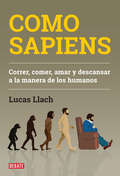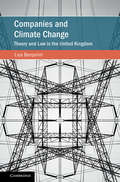- Table View
- List View
Community Adaptation and Vulnerability in Arctic Regions: Framework Document For An International Polar Year Consortium
by Barry Smit Grete K. HovelsrudUnder the auspices of International Polar Year (IPY), the CAVIAR consortium was formed with partners from all eight Arctic countries. The aim of the interdisciplinary CAVIAR project is to increase understanding of the vulnerability of Arctic communities to changing environmental conditions, including climate change, and to contribute to the development of adaptive strategies and policies. In partnership with local collaborators in over two dozen communities, researchers have documented the conditions and forces that contribute to vulnerabilities, identified adaptive strategies and attempted to assess the prospects for adaptation in the future.
Community Biodiversity Management: Promoting resilience and the conservation of plant genetic resources (Issues in Agricultural Biodiversity)
by Walter Simon de Boef Abishkar Subedi Nivaldo Peroni Marja Thijssen Elizabeth O’KeeffeThe conservation and sustainable use of biodiversity are issues that have been high on the policy agenda since the first Earth Summit in Rio in 1992. As part of efforts to implement in situ conservation, a methodology referred to as community biodiversity management (CBM) has been developed by those engaged in this arena. CBM contributes to the empowerment of farming communities to manage their biological resources and make informed decisions on the conservation and use of agrobiodiversity. This book is the first to set out a clear overview of CBM as a methodology for meeting socio-environmental changes. CBM is shown to be a key strategy that promotes community resilience, and contributes to the conservation of plant genetic resources. The authors present the underlying concepts and theories of CBM as well as its methodology and practices, and introduce case studies primarily from Brazil, Ethiopia, France, India, and Nepal. Contributors include farmers, leaders of farmers’ organizations, professionals from conservation and development organizations, students and scientists. The book offers inspiration to all those involved in the conservation and use of agrobiodiversity within livelihood development and presents ideas for the implementation of farmers’ rights. The wide collection of experiences illustrates the efforts made by communities throughout the world to cope with change while using diversity and engaging in learning processes. It links these grassroots efforts with debates in policy arenas as a means to respond to the unpredictable changes, such as climate change, that communities face in sustaining their livelihoods.
Community Empowerment, Sustainable Cities, and Transformative Economies
by Jacob Wood Taha ChaiechiThis edited volume presents the conference papers from the 1st International Conference on Business, Economics, Management, and Sustainability (BEMAS), organized by the Centre for International Trade and Business in Asia (CITBA) at James Cook University.This book argues that the orthodox methods of external risks, climate change adaptation plans, and sustainable economic growth in cities are no longer adequate. These methods, so far, have not only ignored the ongoing structural changes associated with economic development but also failed to account for evolving industries’ composition and the emergence of new comparative advantages and skills. Specifically, this book looks at the vulnerable communities and exposed areas, particularly in urban areas, that tend to experience higher susceptibility to external risks (such as climate change, natural disasters, and public health emergencies) have been largely ignored in incremental adaptation plans. Vulnerable communities and areas not only require different adaptive responses to climate risk but also possess unlocked adaptive capacity that can motivate different patterns of sustainable development to achieve the goals of the 2030 Agenda. It is essential, therefore, to view transformative growth and fundamental reorientation of economic resources as integral parts of the solution. Social disorganisation and vulnerability are other undesired outcomes of the unpredictable and widespread external economic shocks. This is due to a sudden and tough competition between members of society to acquire precious resources, most of which may be depleted during unprecedented events such as natural disasters or pandemics resulting in an even more chaotic and disorganised conditions.
Community Engagement for Sustainable Practices in Higher Education: From Awareness to Action
by Prabhat Mittal Rachna BansalThis book provides a deeper understanding of the concept of community engagement in higher education, encompassing crucial aspects such as stakeholder involvement, collaboration, community organization, and mobilization. It highlights the pivotal role of student engagement in promoting sustainable practices within higher education. The book goes beyond theory by showcasing real-world case studies and best practices from various institutions on successful student-led sustainability projects, campaigns, and initiatives. Furthermore, it uniquely highlights students' efforts in digitalizing communities, reflecting the relevance of technology in modern sustainability practices. It offers actionable insights to effectively engage students and empower them to translate their passion for sustainability into tangible actions. In doing so, the book equips readers to bridge the awareness-action gap, empowering students to implement sustainability practices in real life.
Community Food Initiatives: A Critical Reparative Approach (Routledge Studies in Food, Society and the Environment)
by Stefan Wahlen Oona Morrow Esther VeenThis book examines a diverse range of community food initiatives in light of their everyday practices, innovations, and contestations. While community food initiatives aim to tackle issues like food security, food waste, or food poverty, it is a cause for concern for many when they are framed as the next big "solution" to the problems of the current industrialised food system. They have been critiqued for being too neoliberal, elitist, and localist; for not challenging structural inequalities (e.g. racism, privilege, exclusion, colonialism, capitalism); and for reproducing these inequalities within their own contexts. This edited volume examines the everyday realities of community food initiatives, focusing on both their hopes and their troubles, their limitations and failures, but also their best intentions, missions, and models, alongside their capacity to create hope in difficult times. The stories presented in this book are grounded in contemporary theoretical debates on neoliberalism, diverse economies, food justice, community and inclusion, and social innovation, and help to sharpen these as conceptual tools for interrogating community food initiatives as sites of both hope and trouble. The novelty of this volume is its focus on the everyday doings of these initiatives in particular places and contexts, with different constraints and opportunities. This grounded, relational, and place-based approach allows us to move beyond more traditional framings in which community food initiatives are either applauded for their potential or criticized for their limitations. It enables researchers and practitioners to explore how community food initiatives can realize their potential for creating alternative food futures and generates innovative pathways for theorising the mutual interplay of food production and consumption. This volume will be of great interest to students and scholars of critical food studies, food security, public health, and nutrition as well as human geographers, sociologists, and anthropologists with an interest in food.
Community Forestry
by Ryan C. L. Bullock Kevin S. HannaProviding a critical and incisive examination of community forestry, this is a detailed study of complex issues in local forest governance, community sustainability and grassroots environmentalism. It explores community forestry as an alternative form of local collaborative governance in globally significant developed forest regions, with examples ranging from the Gulf Islands of British Columbia to Scandinavia. Responding to the global trend in devolution of control over forest resources and the ever-increasing need for more sustainable approaches to forest governance, the book highlights both the possibilities and challenges associated with community forestry implementation. It features compelling case studies and accounts from those directly involved with community forestry efforts, providing unique insight into the underlying social processes, issues, events and perceptions. It will equip students, researchers and practitioners with a deep understanding of both the evolution and management of community forestry in a pan-national context.
Community Governance and Citizen-Driven Initiatives in Climate Change Mitigation (Routledge Advances in Climate Change Research)
by Jens Hoff Quentin GaussetOne of the most heartening developments in climate change mitigation in recent years has been the increasing attention paid to the principle of ‘thinking globally and acting locally’. The failure of the international community to reach significant global agreements on the reduction of greenhouse gas emissions has led local governments, environmental organisations and citizens themselves to focus increasingly on the local possibilities for action on climate change. This book analyses the strengths and weaknesses of the co-production of climate policies that take place where citizen engagement and local initiatives converge with public agencies. Case studies from Northern Europe, Australia/New Zealand and the USA reveal that traditional individualist approaches to promoting environmental behaviour epitomised by information campaigns and economic incentives cannot trigger the deep behavioural changes required to materially improve our response to climate change. Only by marshalling the forces of thousands, and eventually millions of citizens, can we manage to reach environmental sceptics, reinforce political action and create the new social norms that are sorely needed in our local, and global, response to climate change. This book will be of great relevance to scholars and policy makers with an interest in climate change politics and governance, community engagement and sustainable development.
Community Lost: The State, Civil Society, and Displaced Survivors of Hurricane Katrina
by Ronald J. Angel Holly Bell Julie Beausoleil Laura LeinNeither government programs nor massive charitable efforts responded adequately to the human crisis that was Hurricane Katrina. In this study, the authors use extensive interviews with Katrina evacuees and reports from service providers to identify what helped or hindered the reestablishment of the lives of hurricane survivors who relocated to Austin, Texas. Drawing on social capital and social network theory, the authors assess the complementary, and often conflicting, roles of FEMA, other governmental agencies, and a range of non-governmental organizations in addressing survivors' short- and longer-term needs. While these organizations came together to assist with immediate emergency needs, even collectively they could not deal with survivors' long-term needs for employment, affordable housing, and personal records necessary to rebuild lives. Community Lost provides empirical evidence that civil society organizations cannot substitute for an efficient and benevolent state, which is necessary for society to function.
Community Planning: An Introduction to the Comprehensive Plan, Second Edition
by Eric Damian KellyThis book introduces community planning as practiced in the United States, focusing on the comprehensive plan. Sometimes known by other names--especially master plan or general plan--the type of plan described here is the predominant form of general governmental planning in the U.S. Although many government agencies make plans for their own programs or facilities, the comprehensive plan is the only planning document that considers multiple programs and that accounts for activities on all land located within the planning area, including both public and private property. Written by a former president of the American Planning Association, Community Planning is thorough, specific, and timely. It addresses such important contemporary issues as sustainability, walkable communities, the role of urban design in public safety, changes in housing needs for a changing population, and multi-modal transportation planning. Unlike competing books, it addresses all of these topics in the context of the local comprehensive plan. There is a broad audience for this book: planning students, practicing planners, and individual citizens who want to better understand local planning and land use controls. Boxes at the end of each chapter explain how professional planners and individual citizens, respectively, typically engage the issues addressed in the chapter. For all readers, Community Planning provides a pragmatic view of the comprehensive plan, clearly explained by a respected authority.
Community Rights, Conservation and Contested Land: The Politics of Natural Resource Governance in Africa
by Fred NelsonNatural resource governance is central to the outcomes of biodiversity conservation efforts and to patterns of economic development, particularly in resource-dependent rural communities. The institutional arrangements that define natural resource governance are outcomes of political processes, whereby numerous groups with often-divergent interests negotiate for access to and control over resources. These political processes determine the outcomes of resource governance reform efforts, such as widespread attempts to decentralize or devolve greater tenure over land and resources to local communities. This volume examines the political dynamics of natural resource governance processes through a range of comparative case studies across east and southern Africa. These cases include both local and national settings, and examine issues such as land rights, tourism development, wildlife conservation, participatory forest management, and the impacts of climate change, and are drawn from both academics and field practitioners working across the region. Published with IUCN, The Bradley Fund for the Environment, SASUSG and Norwegian Ministry of Foreign Affairs
Community Science in Ecology: Case Studies of Public Participation in Ecological Research in Japan (Ecological Research Monographs)
by Yukari Suzuki-OhnoThis book introduces community science (or citizen science) projects in Japan with a focus on ecology. Environments and ecosystems that have been slowly built up over time are changing and collapsing dramatically. In this rapidly changing environment, ecologists need to collaborate with volunteers in their research and activities to investigate and conserve a vast area. This book aims to guide ecologists in the practice of community science. The authors, who are leading ecologists and practitioners of community science projects, share their methods and lessons learned from practice. The book begins with the definition of community science and the following chapters introduce monitoring in ecological community science, using various methods such as observation, specimens, photographs, videos, sounds, and environmental DNA. Readers can learn about the advantages and disadvantages of these methods in ecological community science monitoring. The book also coverstopics such as scientific communication, data obtained from ecological community science monitoring, the rights of participants, decision-making in community science, and conservation activities with volunteers such as invasive alien species extermination and nature restoration. This book serves as a valuable resource for readers interested in ecological community science and its practice. The book is suitable for both undergraduate students and researchers as well as practitioners.
Community Seed Banks: Origins, Evolution and Prospects (Issues in Agricultural Biodiversity)
by Bhuwon Sthapit Ronnie Vernooy Pitambar ShresthaCommunity seed banks first appeared towards the end of the 1980s, established with the support of international and national non-governmental organizations. This book is the first to provide a global review of their development and includes a wide range of case studies. Countries that pioneered various types of community seed banks include Bangladesh, Brazil, Ethiopia, India, Nepal, Nicaragua, the Philippines and Zimbabwe. In the North, a particular type of community seed bank emerged known as a seed-savers network. Such networks were first established in Australia, Canada, the UK and the USA before spreading to other countries. Over time, the number and diversity of seed banks has grown. In Nepal, for example, there are now more than 100 self-described community seed banks whose functions range from pure conservation to commercial seed production. In Brazil, community seed banks operate in various regions of the country. Surprisingly, despite 25 years of history and the rapid growth in number, organizational diversity and geographical coverage of community seed banks, recognition of their roles and contributions has remained scanty. The book reviews their history, evolution, experiences, successes and failures (and reasons why), challenges and prospects. It fills a significant gap in the literature on agricultural biodiversity and conservation, and their contribution to food sovereignty and security.
Community Vision and Leadership in Practice: A Sustainable Approach (Social-Environmental Sustainability)
by Chris Maser Holly V. CampbellThis book is about building and maintaining involved, sustainable, and inclusive communities from the ground up during a period of unprecedented growth and global change. It explains the concepts and principles of community and sustainability and provides students with a framework of sustainable community planning to put into practice. It is also designed to help communities everywhere identify and reconnect the true essence of their ecological setting with the objective of raising their quality of life by increasing social, environmental, and economic sustainability. Features: Provides up-to-date frameworks for sustainable community planning processes and case studies on community planning Explains tools for sustainable planning in accessible (non-specialist) language Illustrates a roadmap to an inclusive, collaborative future Explains aspects of sustainable community planning to maximize ecological ecosystem services and climate co-benefits simultaneously Includes discussion questions and suggestions following each chapter Intended for undergraduate and graduate students taking leadership and community courses with an emphasis on sustainable practices and ethics, as well as for citizens and professionals involved in community projects related to sustainability, the authors provide a forward-thinking approach, showing readers that they are capable of making a positive impact on the future of community development through sustainable approaches and ethical leadership practices.
Community and Climate Resilience in the Semi-Arid Tropics: A Journey of Innovation
by K. V. Raju S. P. WaniThis book focuses on developing an integrated holistic approach for harnessing the potential of rain-fed agriculture. In this approach, rainwater management through harvesting and recharging the groundwater is used as an entry point activity for increasing the productivity for farmers through enhanced water use efficiency. To provide the holistic and integrated solutions, the approach of consortium through building partnerships with different stakeholders, eg. different research institutions (State, National and International), development departments, eg. Department of Agriculture, Department of Animal Husbandry etc., Non-Government Organizations (NGOs), Farmers Organizations Community-based Organizations (CBOs) along with market linkages through private companies.
Community, Environment and Local Governance in Indonesia: Locating the commonweal (Routledge Contemporary Southeast Asia Series)
by Carol Warren John F. McCarthyThis book explores the forces reconfiguring local resource governance in Indonesia since 1998, drawing together original field research undertaken in a decade of dramatic political change. Case studies from across Indonesia’s diverse cultural and ecological landscapes focus on the most significant resource sectors – agriculture, fisheries, forestry, mining and tourism –providing a rare in-depth view of the dynamics shaping social and environmental outcomes in these varied contexts. Debates surrounding the ‘tragedy of the commons’ and environmental governance have focused on institutional considerations of how to craft resource management arrangements in order to further the policy objectives of economic efficiency, social equity and environmental sustainability. The studies in this volume reveal the complexity of resource security issues affecting local communities and user groups in Indonesia as they engage with wider institutional frameworks in a context driven simultaneously by decentralizing and globalizing forces. Through ground up investigations of how local groups with different cultural backgrounds and resource bases are responding to the greater autonomy afforded by Indonesia’s new political constellation, the authors appraise the prospects for rearticulating governance regimes toward a more equitable and sustainable ’commonweal’. This volume offers valuable insights into questions of import to scholars as well as policy-makers concerned with decentralized governance and sustainable resource management.
Community, State, and Market on the North Atlantic Rim: Challenges to Modernity in the Fisheries
by Bonnie Mccay Svein Jentoft Gene Barrett Knut Mikalsen Leigh Mazany Petter Holm Richard ApostleThis is a study of Northern Norway and Atlantic Canada, two regions experiencing a severe crisis due to overexploitation of fisheries resources. The work of a group of researchers from Canada, Norway, and the United States, it examines the implications of common market integration, privatized resource management, and small business development policies for fishery-dependent communities in terms of long-term sustainability and participatory democracy. The book is broken into three sections: an examination of the economic and institutional history of the fisheries in Norway and Atlantic Canada, a study of the regulatory regimes used in the fisheries of these two regions, and an analysis of reactions in three communities, two in Canada and one in Norway, to the decline and collapse of fish stocks. Comparative, multidisciplinary, and multinational in approach, it is a major contribution to the literature on fishing regulations, the role of the state, and resource development in the North Atlantic.
Community-Based Adaptation to Climate Change: Scaling it up
by Hannah Reid Saleemul Huq E. Lisa F. Schipper Jessica Ayers Atiq RahmanAs climate change adaptation rises up the international policy agenda, matched by increasing funds and frameworks for action, there are mounting questions over how to ensure the needs of vulnerable people on the ground are met. Community-based adaptation (CBA) is one growing proposal that argues for tailored support at the local level to enable vulnerable people to identify and implement appropriate community-based responses to climate change themselves. Community Based Adaptation to Climate Change: Scaling it up explores the challenges for meeting the scale of the adaptation challenge through CBA. It asks the fundamental questions: How can we draw replicable lessons to move from place-based projects towards more programmatic adaptation planning? How does CBA fit with larger scale adaptation policy and programmes? How are CBA interventions situated within the institutions that enable or undermine adaptive capacity? Combining the research and experience of prominent adaptation and development theorists and practitioners, this book presents cutting edge knowledge that moves the debate on CBA forward towards effective, appropriate, and ‘scaled-up’ adaptive action.
Community-Based Collaboration: Bridging Socio-Ecological Research and Practice
by Juliana E. Birkhoff E. Franklin Dukes Karen E. FirehockThe debate over the value of community-based environmental collaboration is one that dominates current discussions of the management of public lands and other resources. In Community-Based Collaboration: Bridging Socio-Ecological Research and Practice, the volume's contributors offer an in-depth interdisciplinary exploration of what attracts people to this collaborative mode. The authors address the new institutional roles adopted by community-based collaborators and their interaction with existing governance institutions in order to achieve more holistic solutions to complex environmental challenges. Contributors:Heidi L. Ballard, University of California, Davis * Juliana E. Birkhoff, RESOLVE * Charles Curtin, Antioch University * Cecilia Danks, University of Vermont * E. Franklin Dukes, University of Virginia and George Mason University * María Fernández-Giménez, Colorado State University * Karen E. Firehock, University of Virginia * Melanie Hughes McDermott, Rutgers University * William D. Leach, California State University, Sacramento * Margaret Ann Moote, private consultant * Susan L. Senecah, State University of New York College of Environmental Science and Forestry * Gregg B. Walker, Oregon State University
Community-Based Forest Management (World Forests #22)
by Tapan Kumar Nath Mohammed Jashimuddin Makoto InoueThe book is immensely beneficial to the readers to have a clear understanding of various CBFM practices prevailing in Bangladesh. Providing a comprehensive and critical analysis of success stories concerning several CBFM practices in different forest areas of Bangladesh, together with their respective strengths and weaknesses, it identifies sharing authority to take decision by the community as one of the main weaknesses. The other main weakness is the lack of beat level authority to coordinate with community for making the process vibrant. The book determines that it is the community patrol group which is most effective under the co-management system, yet the general body and executive committee of the co-management system are composed of different stakeholders, each of which is subject to their own work pressures, and are not as effective as claimed. There is a need to empower communities living in and around forests, and to create ownership of the forests so that they can feel that the forests around them are by the community and for the community.
Community-based Water Law and Water Resource Management Reform in Developing Countries
by B. C. P. van Koppen Mark Giordano John ButterworthContributors from various specialties of engineering and of social science analyze operating community-based water laws in Africa, Latin America, and Asia; and critically examine the interface between community-based water laws, formal water laws, and a variety of other institutional dimensions in ongoing water resource management reform. Most of the 15 studies were selected from presentations to a January 2005 international conference in Johannesburg, which focused on rural Africa. Annotation ©2008 Book News, Inc. , Portland, OR (booknews.com)
Community-based adaptation: Mainstreaming into national and local planning
by Hannah ReidCommunity-based adaptation (CBA) to climate change is based on local priorities, needs, knowledge and capacities. Early CBA initiatives were generally implemented by non-government organisations (NGOs), and operated primarily at the local level. Many used ‘bottom-up’ participatory processes to identify the climate change problem and appropriate responses. Small localised stand-alone initiatives are insufficient to address the scale of challenges climate change will bring, however. The causes of vulnerability - such as market or service access, or good governance - also often operate beyond the project level. Larger organisations and national governments have therefore started to implement broader CBA programmes, which provide opportunities to scale up responses and integrate CBA into higher levels of policy and planning. This book shows that it is possible for CBA to remain centred on local priorities, but not necessarily limited to work implemented at the local level. Some chapters address the issue of mainstreaming CBA into government policy and planning processes or into city or sectoral level plans (e.g. on agriculture). Others look at how gender and children’s issues should be mainstreamed into adaptation planning itself, and others describe how tools can be applied, and finance delivered for effective mainstreaming.This book was published as a special issue of Climate and Development.
Como sapiens: Correr, comer, amar y descansar a la manera de los humanos
by Lucas LlachEl conflicto entre nuestros instintos y cuerpo de Homo sapiens y la vida que llevamos es cada vez mayor. ¿Qué humanidad estamos construyendo? Nuestra especie no era la única ni la más prometedora de las varias versiones de humanos en el planeta hace 200.000 años. Pero lo conquistó. Salió de su cuna en África y ocupó todos los continentes. Seleccionó y rediseñó al puñado de animales y vegetales de los que se alimenta. Se multiplicó una y mil veces. Hizo pueblos, ciudades, imperios, guerras, transportes, fábricas e ideas, muchas ideas. El Homo sapiens de hoy es el mismo animal, pero se mueve menos, come peor, trabaja más y tiene menos sexo que sus tatarabuelos africanos. Padece ese desfasaje a cambio de mortalidad baja y pobreza en descenso. Sigue triunfando en su primacía sobre el resto de las especies, pero lo pueden desafiar seriamente una pandemia o una crisis ecológica, o los cambios en su propio cuerpo a medida que la medicina apaga la selección natural y la ingeniería genética imagina humanos de diseño. A prudente distancia de la corrección política y con una dosis importante de humor, este ensayo -que es también crónica- repasa los hallazgos de los últimos años sobre la evolución humana e invita a pensar cómo queremos vivir de ahora en adelante. "Que una especie intente desactivar los mecanismos de la selección natural que operan sobre sí misma, y lo logre casi por completo, es inédito, y ya está redefiniendo al Homo sapiens [...] El ser humano se va convirtiendo gradualmente en Homo medicus, una especie mucho más diversa, formada por descendientes de Homo sapiens que van acumulando variaciones genéticas, útiles o no. Gracias a la medicina, los Homo medicus pueden sobrevivir a los errores de copia, y a su vez necesitan cada vez más de la medicina para que emparche lo que ya no limpia de manera más eficaz y mucho más cruel la selección natural. [...] Pero también es cierto que podemos tratar de moderar esos desequilibrios entre lo que somos y la vida que llevamos. Vivir como sapiens no es volver a ningún tiempo ni lugar específicos. Es tratar de ser conscientes de que somos Homo sapiens (casi iguales, biológicamente, a los de hace cien siglos) nacidos en una cultura para la que el Homo sapiens no está preparado".
Companies and Climate Change: Theory and Law in the United Kingdom (Cambridge Studies on Environment, Energy and Natural Resources Governance)
by Lisa BenjaminCompanies lie at the heart of the climate crisis and are both culpable for, and vulnerable to, its impacts. Rising social and investor concern about the escalating risks of climate change are changing public and investor expectations of businesses and, as a result, corporate approaches to climate change. Dominant corporate norms that put shareholders (and their wealth maximization) at the heart of company law are viewed by many as outdated and in need of reform. Companies and Climate Change analyzes these developments by assessing the regulation and pressures that impact energy companies in the UK, with lessons that apply worldwide. In this work, Lisa Benjamin shows how the Paris Agreement, climate and energy law in the EU and the UK, and transnational human rights and climate litigation, are regulatory and normative developments that illustrate how company law can and should act as a bridge to progressive corporate climate action.
Companion to Environmental Studies
by Mike Hulme Noel Castree James D. ProctorCompanion to Environmental Studies presents a comprehensive and interdisciplinary overview of the key issues, debates, concepts, approaches and questions that together define environmental studies today. The intellectually wide-ranging volume covers approaches in environmental science all the way through to humanistic and post-natural perspectives on the biophysical world. Though many academic disciplines have incorporated studying the environment as part of their curriculum, only in recent years has it become central to the social sciences and humanities rather than mainly the geosciences. ‘The environment’ is now a keyword in everything from fisheries science to international relations to philosophical ethics to cultural studies. The Companion brings these subject areas, and their distinctive perspectives and contributions, together in one accessible volume. Over 150 short chapters written by leading international experts provide concise, authoritative and easy-to-use summaries of all the major and emerging topics dominating the field, while the seven part introductions situate and provide context for section entries. A gateway to deeper understanding is provided via further reading and links to online resources. Companion to Environmental Studies offers an essential one-stop reference to university students, academics, policy makers and others keenly interested in ‘the environmental question’, the answer to which will define the coming century.
Companions in Conflict: Animals in Occupied Palestine
by Penny JohnsonAn award-winning author explores the Israeli-Palestinian conflict through a surprising lens: the animals trying to survive in occupied hotspotsIn August of 2016, Israeli police officers arrested a Palestinian donkey in the Jordan Valley. The charge? Not having the correct paperwork.It's an image as sad (and strangely common) as it is symbolic: No creature great or small is free from the absurdities of the Occupied Territories. Companions in Conflict is a surprising investigation into the deeply intertwined lives of the region's human and animal populations: From camel beauty contests, to a herd of "illegal" Palestinian cows hunted down by Israeli soldiers; from a hyena in a wolf pack that becomes a symbol of Middle East peace, to the tragic story of the now-taxidermied inhabitants of the West Bank's only zoo--who were frightened to death by Israeli explosive devices. Drawing on three decades of living in the region, Penny Johnson's insightful writing reveals what these and many other animals' fates tell us about the current state of Israel and Palestine. What's more, looking forward, she introduces a new generation of environmental activists to us, who represent the region's best hope for conservation, collaboration, and justice for all creatures.
